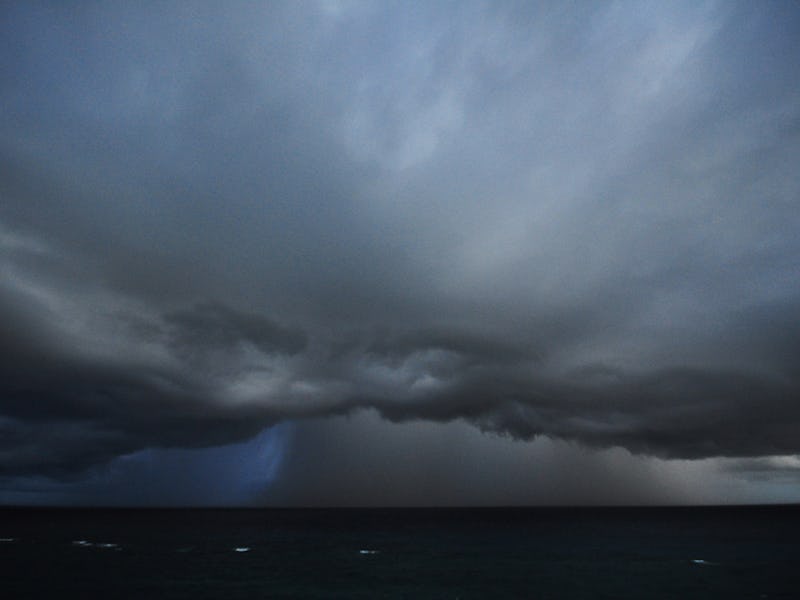Did Science Solve the Bermuda Triangle Mystery? No. That's Not How Science Works
In which we learn a neat lesson about geoscience and that it's impossible to prove a negative.

The Bermuda Triangle is in the headlines this week thanks to a paper by Arctic University of Norway researchers showing oceanic methane bubbles can cause “enormous blowouts,” air pockets large enough to swallow ships. The giant bubbles observed and explained by the Norwegian team were in the Barents Sea, which is nowhere near Hamilton or a decent Dark and Stormy, but a similar phenomenon could — the thinking goes — result in mysterious disappearances. The research posits as probable a theory as any for the disappearance of boats in the Sargasso Sea.
This is all true and fairly logical if one takes the existence of the Bermuda Triangle as a given. The media has largely decided to do just that, which makes one wonder if Summerland or Camelot or Shangri-La will be next and why the rational world still finds it acceptable to link modern science to aging myths.
Let’s start by establishing a clear premise: There is no Bermuda Triangle. Just because you can draw something on a map, does not mean it exists. Plenty of political scientists have made that argument about failed states, but the more appropriate parallel here concerns a doodling cartographer. Does a red polygon scribbled slightly east of the Carolinas mean that there is, in fact, something east of the Carolinas? No. What about if it’s on every map in the entire world? Again, no. Unless there are physical signs or phenomena that prove a thing exists, it is —at best — a collective fiction. Fiction and science don’t play well.
The term “Bermuda Triangle” was coined in 1964 by Vincent Gaddis in an article entitled “The Deadly Bermuda Triangle” that ran in Argosy, a pulp fiction weekly. That context should be indicative of how seriously it should be taken. That said, there is a history of ships mysteriously disappearing in the waters west of Bermuda. In 1918, the USS Cyclops went missing with over 300 sailors aboard. In 1919, the Carroll A. Deering, a schooner, washed up in North Carolina without a crew. These are the sorts of events that rile up landlubbers but not sailors. Why? Sailors know that the wrecks are common the world over and rum runners kill people. If it is in the nature of boats to float, it is equally in their nature to not float. If this was not the case, there would be way more boats clogging every harbor on Earth. You don’t see tall ships every day (unless you live in Annapolis) for a reason. The get sunk or scuttled.
John Huston just wanted to find the truth!
So what, in particular, is singular about the area we refer to as the Bermuda Triangle? That’s hard to say because different people put the triangle in different places, but we can still make some generalization about a stretch of water:
- It’s not particularly dangerous. There is no reason to believe that the Sargasso Sea or the area around it has ever been particularly dangerous to boats or planes, though it was well trafficked at the beginning of the 19th century. Today, drug runners probably represent the most pressing concern for yachtsmen in the area.
- It’s in the Gulf Stream. If a boat stops moving or a plane goes down, it will be heading south on a somewhat unpredictable trajectory.
- It’s in an area where hurricanes happen. Ask Franscisco de Babodilla about it. His fleet went down four and half centuries before someone came up with the idea of a triangle.
None of those details are particularly compelling, yet the media is downright eager to talk about the Bermuda Triangle and to do so scientifically (which is impossible). Why this one specific place? If one reads the stories, the answer becomes clear. The Bermuda Triangle has never been debunked because it can’t be. Proving a negative is nearly, if not entirely, impossible. So, pointing to a dearth of evidence supporting the conclusion that anything is going on doesn’t accomplish much. The Bermuda Triangle will always be there for the same reason the Flying Spaghetti Monster and the concept of “clutch hitting” in baseball aren’t going away any time soon. It’s a sticky idea that lingers because it is fundamentally abstract.
What’s fascinating about the methane bubble story boom is that each article represents, in essence, an attempt to understand a social phenomenon using geoscience. Belief is a social phenomenon. Methane bubbles are a geological one. The one has very little bearing on the other, but just try to keep culture from impinging on science and science from trying to explain away culture. It’s impossible so long as the people in the middle are tasked with telling stories.
The methane bubble story is a good story. So was the original Bermuda Triangle story. Let’s just leave Norwegian gas experts the hell out of it.